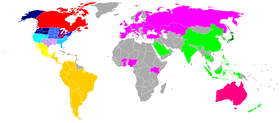
Intermediate, Junior, and Senior League Baseball are youth baseball divisions of Little League Baseball that are considered more advanced and difficult than younger Little League divisions due to more advanced rules, including the ability to lead-off and steal as the pitcher breaks, along with longer base paths and greater pitching distance. Junior League also includes the use of bats with Template:USSSA bats rather than the transitional Template:USA bats of Little League. Junior League also allows the use of metal spikes in cleats in addition to the molded or plastic spikes used in Little League. The Big League level was discontinued in the baseball and softball divisions — after the 2016 Big League World Series.
The Big League World Series (BLWS) West Region was one of five United States regions that sent teams to the World Series. The Big League division of Little League Baseball was discontinued after the 2016 World Series. The region's participation in the BLWS had dated back to 1968.
The Junior League World Series Central Region is one of six United States regions that currently sends teams to the World Series in Taylor, Michigan. The region's participation in the JLWS dates back to 1981.
The Junior League World Series East Region is one of six United States regions that currently sends teams to the World Series in Taylor, Michigan. The region's participation in the JLWS dates back to 1981.
The Junior League World Series Southeast and Southwest regions—formerly the South Region, until 2002—are two of the six United States regions that currently send teams to the World Series in Taylor, Michigan. Together, the regions' participation in the JLWS dates back to 1981.
The Junior League World Series Asia–Pacific Region is one of six International regions that currently sends teams to the World Series in Taylor, Michigan. The region's participation in the JLWS dates back to 1999.
The Junior League World Series Canada Region is one of six International regions that currently sends teams to the World Series in Taylor, Michigan. The region's participation in the JLWS dates back to 1988.
The Junior League World Series Europe–Africa Region is one of six International regions that currently sends teams to the World Series in Taylor, Michigan. The region's participation in the JLWS dates back to 1990.
The Junior League World Series Latin America Region is one of six International regions that currently sends teams to the World Series in Taylor, Michigan. The region's participation in the JLWS dates back to 2000.
The Intermediate League World Series Central Region is one of five United States regions that currently sends teams to the World Series in Livermore, California. The region's participation in the ILWS dates back to 2013.
The Intermediate League World Series East Region is one of five United States regions that currently sends teams to the World Series in Livermore, California. The region's participation in the ILWS dates back to 2013.
The Intermediate League World Series (ILWS) Southeast Region and Southwest Region are two of the five United States regions that currently send teams to the World Series in Livermore, California. The two regions were created in 2013, when the ILWS began
The Intermediate League World Series West Region is one of five United States regions that currently sends teams to the Intermediate League World Series in Livermore, California. The region's participation in the ILWS dates back to 2013.
The Intermediate League World Series Asia–Pacific Region is one of six International regions that currently sends teams to the World Series in Livermore, California. The region's participation in the ILWS dates back to 2013.
The Intermediate League World Series Canada Region is one of six International regions that currently sends teams to the World Series in Livermore, California. The region's participation in the ILWS dates back to 2013.
The Senior League World Series West Region is one of six United States regions that currently sends teams to the World Series in Easley, South Carolina. The region's participation in the SLWS dates back to 1962.
The Junior League World Series Australia Region is one of six International regions that currently sends teams to the World Series in Taylor, Michigan. The region's participation in the JLWS dates back to 2016.
The Junior League World Series Host team is one of six United States regions that sends teams to the World Series in Taylor, Michigan. The host team first competed in the JLWS in 1985. It was discontinued after 1989, but returned in 2018.
The 1981 Junior League World Series took place from August 18–21 in Taylor, Michigan, United States. Boardman, Ohio defeated Richmond, Virginia in the championship game.
The 2019 Junior League World Series took place from August 11–18 in Taylor, Michigan. Fullerton, Southern California defeated Guayama, Puerto Rico in the championship game.






